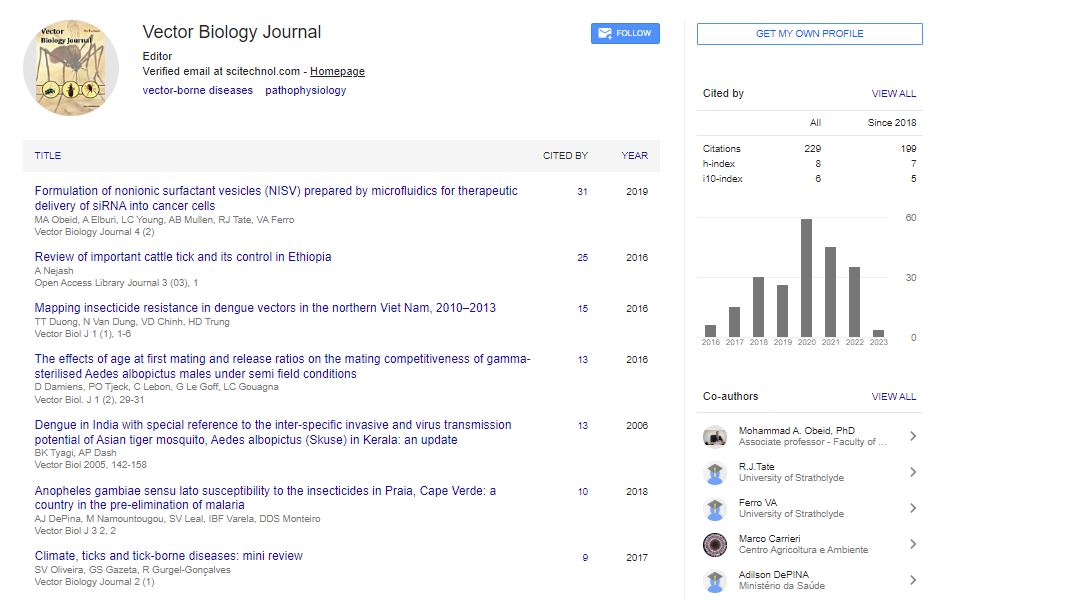Perspective, Vector Biol J Vol: 8 Issue: 3
Vector Mortality and Vaccine-Conferred Survival Increases in Prairie Dogs
Zou Teutsch*
1Department of Biological Sciences, Auburn University, AL 36849, USA
*Corresponding Author: Zou Teutsch,
Department of Biological Sciences,
Auburn University, AL 36849, USA
E-mail: Teutsch123@gmail.com
Received date: 28 August, 2023, Manuscript No. VBJ-23-117767;
Editor assigned date: 30 August, 2023, PreQC No. VBJ-23-117767 (PQ);
Reviewed date: 13 September, 2023, QC No. VBJ-23-117767;
Revised date: 21 September, 2023, Manuscript No. VBJ-23-117767 (R);
Published date: 29 September, 2023, DOI: 10.4172/2473-4810.1000277
Citation: Teutsch Z (2023) Vector Mortality and Vaccine-Conferred Survival Increases in Prairie Dogs. Vector Biol J 8:3.
Description
Prairie dogs (Cynomys spp.) are iconic burrowing rodents of North American grasslands, playing important roles in ecosystem dynamics. These animals face numerous threats, including diseases transmitted by vectors such as fleas. This study explores the impact of vectorborne mortality in prairie dogs and the potential of vaccines to enhance their survival rates. Through field studies and controlled experiments, we investigate the complex interplay between vector mortality and vaccine-induced immunity in prairie dog populations.
Prairie dogs are keystone species in North American grasslands, contributing to ecosystem health by modifying vegetation and creating habitats for a wide array of species. However, prairie dogs are threatened by vector-borne diseases, especially plague, which can decimate entire colonies. This study delves into the relationship between vector mortality and vaccine-conferred survival increases in prairie dog populations.
Vector-borne mortality in prairie dogs
Vector-borne diseases in prairie dogs are primarily transmitted through fleas (Oropsylla spp.), which can carry the causative agent of plague, Yersinia pestis. These fleas serve as vectors, transmitting the bacterium to prairie dogs when they bite. Plague can rapidly spread through colonies, leading to significant mortality.
In field studies, we examined the impact of plague on prairie dog populations. We found that vector-borne mortality can lead to substantial declines in colonies, with fatality rates exceeding 90% in some cases. Such losses can have cascading effects on ecosystems, affecting predator-prey relationships and plant dynamics.
Vaccine-conferred survival increases
To combat vector-borne diseases in prairie dogs, researchers have developed vaccines designed to confer immunity against Yersinia pestis. In controlled experiments, we administered these vaccines to prairie dog populations and assessed their effects.
The results demonstrated a significant increase in survival rates among vaccinated individuals compared to non-vaccinated controls. This promising outcome suggests that vaccines can help prairie dog populations withstand vector-borne diseases and potentially halt the decline of colonies.
The interplay between vector mortality and vaccination
Our analysis indicates that the interplay between vector mortality and vaccination is a complex process. The presence of vaccinated individuals in a colony reduces the prevalence of plague, ultimately lowering the overall vector-borne mortality rate. However, this effect is influenced by several factors:
Vaccine coverage: The degree of protection within a population depends on the percentage of individuals vaccinated. Higher coverage rates correlate with greater survival increases.
Herd immunity: When a difficult proportion of individuals within a colony is vaccinated, herd immunity can develop, providing indirect protection to unvaccinated individuals by reducing the pathogen's circulation.
Vector dynamics: Vaccination can indirectly influence flea populations, as it reduces the availability of susceptible hosts. Fewer susceptible prairie dogs can lead to lower flea numbers, further diminishing the likelihood of vector-borne disease transmission.
Implications for prairie dog conservation
Understanding the dynamics between vector mortality and vaccination in prairie dog populations has vital implications for conservation efforts. Protecting these keystone species is essential for maintaining the health and diversity of grassland ecosystems.
Vaccination programs could be an effective tool for conserving prairie dogs and their habitats. By reducing vector-borne mortality, these programs can promote prairie dog colony stability and contribute to the overall health of grassland ecosystems.
Future directions
The study of vector mortality and vaccine-conferred survival increases in prairie dogs offers a promising avenue for further analysis. Future investigations could focus on optimizing vaccine delivery methods, refining vaccination strategies, and assessing the long-term impacts on prairie dog populations and the broader ecosystem.
Additionally, investigating the potential of vaccines against other vector-borne diseases, such as tularemia and sylvatic plague, could expand our understanding of disease management in prairie dog communities.
Conclusion
Vector-borne diseases pose a significant threat to prairie dogs and the ecosystems they inhabit. This study highlights the importance of understanding the complex interplay between vector mortality and vaccine-conferred survival increases in prairie dog populations. Through careful analysis and conservation efforts, we can enhance the resilience of prairie dogs and, in turn, safeguard the health and diversity of North American grasslands.
 Spanish
Spanish  Chinese
Chinese  Russian
Russian  German
German  French
French  Japanese
Japanese  Portuguese
Portuguese  Hindi
Hindi 